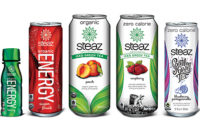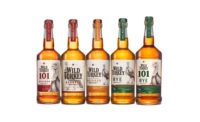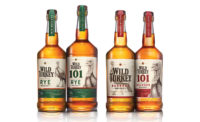CORE VALUES
By SARAH THEODORE
Independence and innovation lead to healthy growth at
Apple & Eve
Apple & Eve has reason
to feel good. Not only is it part of the successful “better for
you” beverage market, but it is celebrating its 30th anniversary this
year with two landmark events — breaking through the $100-million
sales mark and acquiring Northland Cranberries, its first acquisition.
Founded in 1975 by Chief Executive Officer Gordon
Crane, Apple & Eve has grown from a small family-owned apple juice
company to a national business with more than 100 products. But it’s
still a family-run operation, and Crane says its culture remains very much
the way it was when the company began.
“The company ethos and mission statement has
changed very little in 30 years,” Crane says. “We started out
with a focus on healthy, better-for-you, pure juice products, and here it
is 30 years later and we really have not strayed much from that basic premise.”
Crane describes the 1970s version of himself who
founded the company as a “long-haired hippie interested in
macrobiotics and natural foods and changing the world.” The premise
might have been appealing to a small group then, but it has grown in
popularity and the better-for-you market is the place to be in 2005.
“Thirty years ago, Apple & Eve started with
a very strong proposition, which was 100-percent pure juice,” says
Jeff Damiano, director of marketing and new product development.
“It’s almost as if the rest of the world is catching up to
us.”
Apple & Eve’s lineup consists mainly of
100-percent, no-sugar-added juices. The original unfiltered apple juice has
expanded to cover a variety of juice blends, including a strong presence in
the cranberry segment, made even stronger by the Northland acquisition.
“Our growth strategy never included acquisition
and that was because we felt we had so much opportunity and so much growth
potential under the Apple & Eve brand portfolio of products,”
Crane says.
But, he adds, Northland’s premium product image
and 100-percent juice lineup fit well with Apple & Eve. “Apple
& Eve is a premium juice company and Northland epitomizes premium in a
way that few other brands have achieved.”
The acquisition makes Apple & Eve the leading
provider of 100-percent juice products in the cranberry segment and adds
the Seneca brand license, TreeSweet and Awake brands to the mix. It also
will put company sales at more than $160 million this year, and gives it
access to a wider range of customers in the important grocery channel.
“It completely opens up the United States for
us,” says Cary Crane, executive vice president of sales, and one of
Crane’s brothers who joined him in the business. A second brother,
Alan, serves as single-serve, Southeast regional sales manager.
“The strength of Apple & Eve in the grocery
business was the East Coast; we are now national with the grocery trade. It
gives Apple & Eve an audience with many retailers that presently
we’re not calling on.
“People are surprised when they hear that Apple
& Eve bought Northland,” he adds. “Northland was national
but with just cranberry juice. Apple & Eve is regional but with so many
different products that we sell. So when you add up all the little things
that we do, we’re much larger than people perceived.”
Even before the acquisition, Apple & Eve had
distribution beyond its main East Coast base. In the western part of the
country, it had a strong club store business, and in several markets such
as Los Angeles, parts of Texas, Michigan, Ohio and Indiana, it was
available through grocery outlets. But from Maine to Florida, the company
has distribution in virtually every retail channel, including a
single-serve direct-store-delivery business, grocery, drug, natural foods
and club stores.
A multidisciplined approach
Getting into the club store channel was one of Apple
& Eve’s first achievements, and provided the impetus for creating
its best-selling products today, juice boxes.
According to Cary Crane, it was a potential club store
customer who suggested the idea of a 100-percent juice in an aseptic
variety pack. “I left there and said, ‘I don’t know how
we’re going to do it, but we’re going to do it.’ And I
came back here and we figured out a way to do it. It’s that kind of
‘just get it done’ attitude that we’ve established
here.”
Apple & Eve considers its speed and agility to be
some of its greatest assets. “One of the reasons for our success is
our ability to move quickly,” Gordon Crane says. “There are not
a lot of layers, and there’s a strong entrepreneurial spirit and an
ability to stay in touch with the changing needs of our consumers
“From label design to packaging and bottling, we
can get a product out in four to six weeks,” Cary Crane adds.
“I don’t think anyone can get a product to market quicker than
we can.”
Apple & Eve’s headquarters includes an
in-house R&D lab for formulation work, and Damiano says the company
looks to all aspects of the business, from ingredients to financials, to
innovate.
“Innovation is not just about coming out with a
new flavor or a new package,” he says. “It’s about coming
out with a new flavor or new package that we can deliver to the consumer at
the right price point and get into the right distribution channels.
Apple & Eve’s Organics line, which was
introduced in 2003, is an example of incorporating pricing as well as
consumer trends in the innovation equation. The company’s
relationship with natural foods retailers tipped it off to increasing
organic sales and the potential to expand the market for organics by
packaging and pricing them for more mainstream channels.
“The benefit of working within the natural
products class of trade is that we have found a lot of emerging ideas
incubate in the natural products network,” Damiano says. “It
made perfect sense for Apple & Eve to have a line of organics. But what
we were seeing is that organics were no longer just being distributed to
natural food stores. They were rapidly becoming a mainstream opportunity.
Our line of Organics was developed not just for Whole Foods, but also for
our grocery class of trade.”
The Organics line is available in 48- and 64-ounce PET
rather than the traditional 32-ounce glass used for organic juices (Organic
Apple also is available in a 128-ounce size), carries the FDA Organic logo
and is certified by Quality Assurance International.
Another new product, Apple & Eve’s Tropicals
line, was added last year to address the company’s growing Hispanic
market.
“There are so many people in the United States
from South America and Mexico,” Cary Crane says. “These
tropical blends fit a need for these consumers, yet we’re finding
that they work just as well among mainstream consumers.
“There’s nobody out there marketing these
types of products mainstream,” he adds. “You’ll see it in
single-serve, but not in supermarkets in the 64-ounce size.”
Family focus
Apple & Eve’s drinks are primarily
family-targeted products — for kids specifically and for mothers
shopping for families. In 1999, it became the first company to license
Sesame Street characters for food products, and it is the exclusive
licensee of the characters for juices.
Gordon Crane says many of the company’s early
choices were based on personal knowledge and involvement with the product
category. The decision to partner with Sesame Street, for example, was
based on raising kids and knowing the characters with whom they identified.
Today it is based as much on listening to consumers as it is on living
industry trends.
“Some of those early firsts — in 1975,
natural-style fruit juice sold to supermarkets; 1978, the first 100-percent
cranberry juice blend; 1982, the first 100 percent juices in an aseptic
‘juice box’ — were things that we were living at the
time,” he says. “Now it’s the question of how do we stay
in tune with changing demographics, and that’s by talking to our
consumers and staying very aware of our consumers changing
needs.”
Another example of the company’s quest to have a
presence across all classes of trade has been its venture into the
convenience store channel. The company made the decision three years ago to
introduce a 16-ounce single-serve line of juices through a
direct-store-delivery distributor network. So far, it says, the decision is
proving to be a savvy move.
Last year, Apple & Eve picked Bill Harrison, a
veteran in the single-serve channel, to head its growing single-serve
division. Harrison recognized that success in the channel would depend
heavily on partnerships with its distributor network. He has continued the
expansion of the brand geographically beyond Apple & Eve’s core
Northeast market into the Mid-Atlantic, Southeast and Midwest sections of
the country.
During the past year, Apple & Eve has steadily
expanded its single-serve line through new products such as Guava and Mango
Nectars with bilingual labels. There also have been some stumbling blocks
such as the introduction of a light line, which proved untimely as it was
launched at the end of the “low-carb” fad. This year, however,
the company followed with the introduction of a new tropical-flavored
100-percent juice blend, Strawberry Mango Passion, as well as Half &
Half, a lemonade and iced tea blend.
The lighter side
Last year’s low-carb craze left many juice
companies in the cold — at least temporarily. But Apple & Eve
says its products weathered the storm, partly because of their 100-percent
juice content.
“I think our brand as a whole was pretty
resilient in light of low-carb because I think there are different factors
influencing it,” says Brad Angevine, vice president of marketing.
“The main factor is we’re seeing people try to eat and drink
more healthy. There’s always been a value placed on 100-percent
juice. That protected us a lot.”
Nevertheless, the company introduced Apple & Eve
Light & Fruitful juices with Splenda. The drinks contain two-thirds
fewer calories than traditional juices and 9 grams of carbohydrates.
According to Gordon Crane, the idea of an artificially
sweetened product was the cause of much internal debate, but the company
eventually decided it was an unavoidable part of today’s
better-for-you trend.
“Low-carb burned out, but what didn’t fade
was a continued interest in low-calorie and the interest in obesity,”
he says. “Therefore, marketing companies
such as ourselves have adapted to some of those changes.”
The addition of a low-calorie juice is one of many
changes Apple & Eve has adapted to during its three-decade history, but
the company says it has built its business in small steps rather than giant
leaps into temporarily trendy categories, and there are plenty more
opportunities in the future.
“I never dreamed [in the beginning], or even in
the early years, that we would have survived this many years — that
we would not only have survived but prospered and grown the way we
have,” Gordon Crane says.
And Cary Crane adds, “We haven’t even
scratched the surface for the potential of Apple
& Eve.” BI
Creative differences
Apple & Eve and Northland products are
both 100-percent juices, but they have different profiles and
personalities, and the company says it plans to maintain both brands and
position them differently.
“We’re really talking to women,”
says Jeff Damiano, director of marketing and new product development.
“Under Apple & Eve it’s women within the family profile,
women with children.
“Northland is also a powerhouse brand within the
category of 100-percent juice cranberry blends. But they speak to women
with a somewhat different voice. It’s really women for their own
personal health and wellness.”
“The two brands have different taste profiles
and different formulations,” adds Brad Angevine, vice president of
marketing. “Apple & Eve is much more focused on broad family
appeal. Northland has a taste profile that is more adult focused and has a
more tart taste.”
Northland historically has used national media
advertising, which Angevine says, “helped them communicate their
message to the female adult consumer and talk about sophisticated, complex
[health] topics, and we’re going to continue to provide that kind of
marketing support.”
Apple & Eve, on the other hand, uses a more
grassroots approach, including event sponsorships for organizations such as
the American Diabetes Association and local Big Brothers and Big Sisters
chapters.
“We’re going to continue to have different
ways of going to market and supporting our brands as we go forward, but we
see both brands as having strong potential,” Angevine says.


